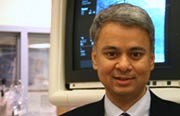Practicality Prevails in Treating Diabetes and Heart Disease
With a 12% diabetes rate and a third of its residents under the poverty line, the Bronx presents some of the nation’s highest healthcare needs and largest access barriers. To this borough, and to a world facing an unprecedented diabetes pandemic, “eat right, quit smoking, and take your medicine” might seem tame, even outdated. However, this strategy could be our best weapon yet, according to results from the worldwide Bypass Angioplasty Revascularization Investigation 2 Diabetes (BARI 2D).

Image: V.S. Srinivas, MB, BS

Image: Joel Zonszein, MD
Diabetes is projected to afflict over 340 million worldwide by 2030, and 84% of diabetes-related deaths involve heart disease or stroke. The BARI 2D study followed patients with type 2 diabetes and documented stable coronary artery disease, all of whom received aggressive medical therapy (medications). The study compared the effectiveness of insulin-providing versus insulin-sensitizing medication strategies, and whether elective coronary revascularization (bypass, angioplasty, stenting) was effective when combined with medications.
The study was unique in that it didn’t set out to test a new drug or surgical intervention; rather, it examined commonly prescribed drugs and current revascularization methods, joining them in four different ways to determine the best recipe. Five years, six countries, 49 medical centers, and 2,368 patients later, BARI 2D, the largest heart disease and diabetes study ever, met with considerable misinterpretation and criticism. Responses included headlines such as, “CABG Edges Out PCI in Diabetes”, and letters to the New England Journal of Medicine stating, “The results of this study are difficult to translate into clinical practice.”
“BARI 2D was too complex to be covered in a single sound byte. We weren’t surprised when the press overlooked parts of it,” said V.S. Srinivas, associate professor of medicine (Cardiology) and principal cardiology investigator for the trial. “This was the first time we looked at the whole patient and asked, ‘If we treat both the diabetes and the heart disease aggressively while controlling everything else, what will this patient’s health look like in 5 years?’”
“A lot of issues were missed because this was a neutral trial,” agreed Joel Zonszein, Director of the Montefiore Clinical Diabetes Center and principal diabetes investigator. “It wasn’t a trial comparing diabetes drugs. Rather, BARI2D compared two different strategies to bring down blood sugar levels.”
The Insulin Dilemma: Is More Better?
BARI 2D evaluated whether adding insulin (insulin providing) or helping the body make better use of its existing insulin (insulin sensitizing) more effectively controlled blood sugar levels, and which strategy was better for cardiovascular events.
At 88%, the five-year survival rate for both groups was high. Patients who received insulin-sensitizing medications (e.g., Thiazolidinediones or Metformin) had slightly fewer severe low-blood-sugar episodes, less weight gain, and higher HDL ("good cholesterol") levels than those who received insulin-providing drugs (Sulfonylureas, Repaglinide, Nateglinide, and/or insulins), suggesting that insulin sensitization may be better for patients with type 2 diabetes.
To Stent or Not to Stent
The trial compared prompt revascularization with delayed or no revascularization in patients with early-stage heart disease, all of whom were treated with medication to control blood sugar, blood pressure, and cholesterol.
In patients with type 2 diabetes high LDL (“bad cholesterol”) can lead to artery hardening and blockage, strongly associated with high blood pressure, heart disease, and stroke. Arterial blockage is often treated with surgical revascularization, either coronary artery bypass graft (CABG), which reroutes the blood flow around the blocked vessel, or percutaneous intervention (PCI) and stenting, which widens and stabilizes clogged arteries.
Results showed that revascularization held no particular advantage over intensive drug therapy. Over a million CABGs and PCIs are performed each year in the United States. More judicious use of these procedures, as well as fewer stress tests and angiograms (now considered unnecessary for asymptomatic or mildly symptomatic heart disease), could lower surgical risk and radiation exposure and save billions of healthcare dollars.
“It would have been better for me as an interventionalist if we had found stenting favorable. It's easier to implant a stent than to get patients’ conditions under control, especially when they might lose their employment and their insurance,” said Srinivas. “BARI 2D has raised the bar—I have changed my own practice, and now teach a high threshold where medical therapy is concerned.”
“Intensive medical therapy is difficult to execute because patients don’t want to take medications, but our evidence shows that early and aggressive therapy is an important and effective strategy,” agreed Zonszein.
Adherence Strong Amidst Adversity
The 81 patients at the Montefiore Einstein BARI 2D site had significant time demands: some worked multiple jobs, others were raising young children and grandchildren. BARI 2D required a significant commitment, including as many as twelve different medications taken daily, doctors visits (necessary each month for the first six months and every three months thereafter), and nutrition and smoking cessation counseling (provided to all). Despite the challenges, 95% of the participants completed the study, and 90% made every appointment, “We were surprised by how well our patients responded,” said Helena Duffy, coordinator of the diabetes component. “People who had been sedentary for years became highly motivated, made lifestyle changes, and took their medications regularly. It was wonderful to see them excited about getting their blood sugar down and their cholesterol in range.”
“Our patients left the office smiling and happier than when they arrived,” agreed Eugen Vartolomei, coordinator of the cardiology component. “They gained confidence as they learned that they could control their conditions by monitoring their blood sugar and complying with their treatment goals.”
Fostering these changes, however, took a toll. “Following the patients weekly was physically exhausting, especially for our coordinators,” said Srinivas. “None of us knew how much effort it would take to manage them.”
“Without a doubt the success of the study was due to the intensive care provided by our coordinators,” Zonszein agreed. “BARI 2D reinforced high standards of medical care and further illustrates the benefit of clinical trials in the Bronx.”
In this largely uninsured community where fast food chains prevail over produce markets, creating and sustaining behavior modification is a daunting task. “Patients don’t like to take medication, saying they will change their lifestyle instead. But they will have much better outcomes with both,” said Zonszein. “More and more we want to diagnose diabetes early and treat it aggressively. High blood sugar, even for a short time, causes short- and long-term damage.”
“BARI 2D has put the ball back into the patient's court,” Srinivas said. “By being aware of their conditions and knowing how to reduce their risk—diet, exercise, taking a statin, knowing their blood pressure—patients with diabetes and heart disease will experience better outcomes.”